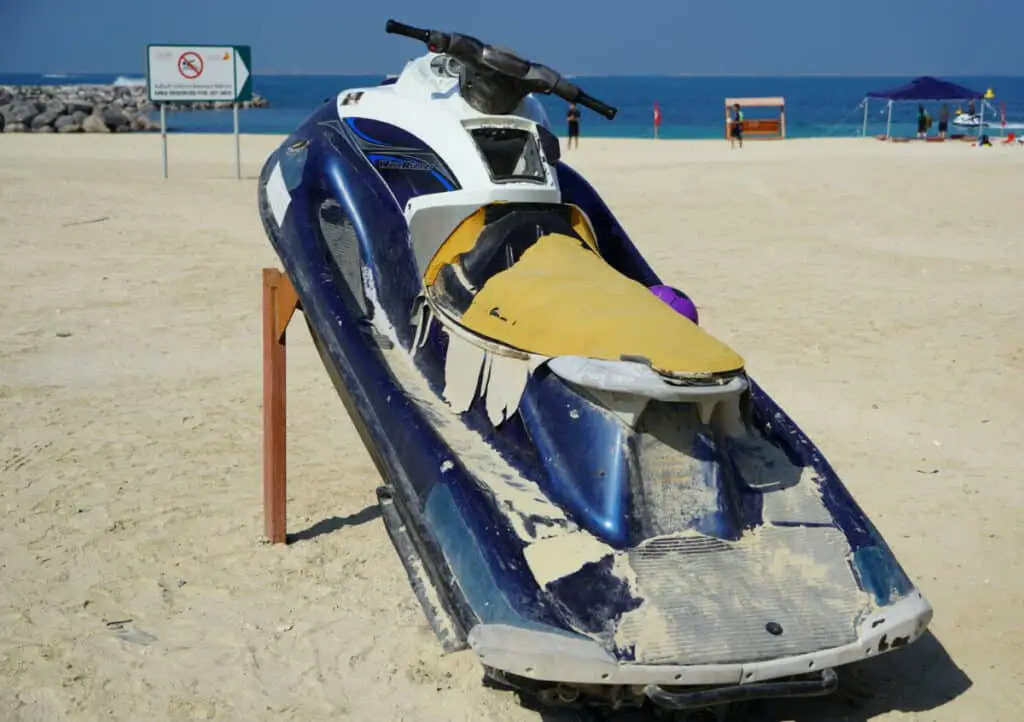
Warm wind in your face, mist on your skin, and a lake below your feet—there are few experiences as exhilarating as flying across the water on a jet ski. Still, if you don’t use your jet ski anymore or it has stopped working, you may be wondering what you can do with it to free up some storage space.
To get rid of an old jet ski, consider donating or selling it to someone else. Jet Skis are popular watercraft vessels so they are easy to sell and donate. Boat salvage yards will also accept old jet skis for their viable parts, turning a profit with the scraps before recycling the rest.
Any one of these options will be just as easy as bringing the old jet ski to a dump, if not easier. But by choosing a sustainable disposal method, you’ll be making a positive impact on the environment and the lives of others.
Donating a Used Jet Ski
First of all, if your jet ski still works and you just want to get rid of it, you will have almost no problem finding someone who wants it. Anyone who has gone jet skiing with a friend but has never been able to afford one of their own will be eager to take it off of your hands.
There are also various nonprofit organizations that accept used jet skis and provide them for underprivileged children, veterans, and others in need a boost of positivity in their lives. When looking for a nonprofit that will accept jet skis, don’t be confused by the name of the organization. Wheels for Wishes, Goodwill Car Donations, and Veteran Car Donations all sound like organizations that primarily deal with used cars, but they actually accept all used vehicles, including watercraft.
Selling a Used Jet Ski
You can almost always sell a used jet ski, even a very old one. Jet skis depreciate about 22% after the first year of use, but you can still sell it for a decent price down the road. Depending on the age and condition, a used jet ski can fetch a resale price of anywhere between $5,000 to $20,000. Needless to say, if you’re up for the hassle of listing and selling your watercraft, your efforts will be rewarded.

When selling a used jet ski, there are several ethical factors to keep in mind. Be honest about the number of hours the jet ski has been operated. You don’t need to know an exact number (it’s almost impossible to track precisely) but a rough estimate of the vessel’s level of use will help the buyer know about how much longer it will continue to operate safely before they need to handle repairs or maintenance.
If you have taken the jet ski to a shop for maintenance or repairs before, hold on to the records for reference. Presenting documentation of the watercraft’s functional history will build trust with the buyer, not to mention the fact the it will help them be safe while using it later. Buyers keep an eye out for these documents; if you can provide them, you’ll sell the jet ski in no time.
Boat Salvage Yard
If you don’t want to deal with the hassle of donating or selling the jet ski, consider locating a boat salvage yard near you. Chances are, if you own a jet ski, you probably live near a lake, reservoir, or ocean. Communities near large bodies of water usually have lots of residents who own boats and other vessels, which means that there’s a higher turnover of used watercraft equipment. In an area like this, you’re more than likely to have access to a boat salvage yard.
Boat salvage yards take used vessels and sell their viable parts for a profit. They accept boats and jet skis of all types and varieties (wave runners, sea-doo’s, etc.); you can even make some money, if your used vessel is still worth something. However, if you want to ensure that the parts of your jet ski are recycled, they may charge you a fee for the disassembly and waste management labor.
Beyond the complications of recycling, the salvaging process is pretty straightforward. First, the motor is removed from the watercraft and the fluids are drained from it. Gas and oil always need to be handled according to state laws, which is why this first step is critical. After the motor is taken care of, the jet ski will be disassembled and recyclable parts will be separated by material. Anything that is metal or glass has a chance of turning a profit, since repair shops and jet ski owners are often looking for cheap replacement parts.
Old Jet Ski Hulls Recycling
Since the hull of a jet ski is made of metal components, it can almost entirely be recycled. If you are not able to remove the hull on your own, take the jet ski to a scrap yard and request that they salvage the metal for purchase. Some scrapyards will require any fiberglass to be removed, but policies like that are not common. Contact local waste management facilities to learn about fiberglass disposal options near you.
Avoid bringing the jet ski directly to a landfill; fiberglass laminates often only contain about 25% organic materials, meaning they will take years to break down and decompose. While it sits in the landfill, fiberglass will release dangerous quantities of ash. This is why it is on the Hazardous Substance List, and why you should always contact a waste management facility for professional input.

Average Jet Ski Lifespan
If you’ve owned and enjoyed your jet ski for several years, you may be wondering just how much life it has left. The answer to that question completely depends on how regularly you maintained it an how responsibly you used it. New jet skis usually last for about a decade of use, which is pretty incredible. That translates to about 300 hours of time cruising around on the water! So if the jet ski less than ten years old, you can be sure that it’s still got some waterborne adventures in store for the next owner. If the jet ski is older than ten years, your best options are scrapping and repurposing the parts.
Related Topics:
If you like the article above, here are some other similar articles you should check out!
What Should I Do with Old Slim Cards
